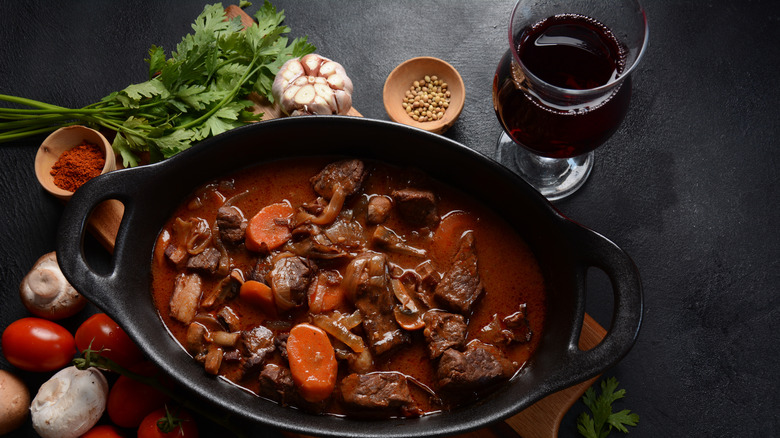Anthony Bourdain's Wine For Beef Bourguignon Doesn't Actually Exist
Anthony Bourdain was known for being brash and controversial, but when it came to pairing wine with his signature beef bourguignon, he took a wholly traditional route. Beef bourguignon, or burgundy — its anglicized name — is a hearty dish comprised of slow-cooked chunks of beef, carrots, onion, fresh herbs, and plenty of red wine.
While some might assume it's best to serve beef bourguignon with a big, hearty red wine, like a Bordeaux or even a California Cabernet or Merlot, the dish is actually better suited to its namesake wine, one from Burgundy, and that's precisely what Bourdain chose ... well, that's sort of what he chose. According to The Washington Post, as well as Bourdain's Les Halles Cookbook, his choice of Burgundy was a Côte de Nuits Villages Pommard.
The outlet first published Bourdain's beef bourguignon recipe in 2004, and it went on to become one of the most popular recipes the W.P. ever printed — so popular that the paper published an article about how popular it was just two years ago. In that article, readers got a primer on how red Burgundy is made from the Pinot Noir grape, but what's perhaps most interesting about Bourdain's pairing is the fact that the wine he suggested doesn't actually exist.
How is it possible Bourdain's wine doesn't exist?
The wines of Burgundy are notoriously difficult to understand. How difficult? Renowned wine critic Robert Parker's tome on the wines of Burgundy is 1052 pages long, including the index. Burgundy is divided into several growing regions, one of which is indeed the Côte de Nuits. Other regions include Côte Chalonnaise, Mâconnais, and Côte de Beaune.
Wines from Burgundy can come from unclassified vineyards, and they're simply labeled "Bourgogne Blanc" or "Bourgogne Rouge." But certain areas of Burgundy are classified, meaning they're from places with a distinctive terroir. One of those classifications is the name of the commune or village the wine comes from. According to Wine Folly, there are a total of 44 village designations, and one of those happens to be Pommard.
While, as we mentioned, Côte de Nuits is a real growing region, the village that Bourdain identified, Pommard, isn't a part of it. Pommard is actually in the Côte de Beaune. Quite simply, you can't find a Côte de Nuits Villages Pommard because it doesn't exist. Given the fact that the relatively small Burgundy region has within it 785 different appellations, the mistake is certainly understandable, but it is indeed a mistake.
Oh — and for the record, a Pommard from the Côte de Beaune would be absolutely delicious with Bourdain's beef bourguignon.

